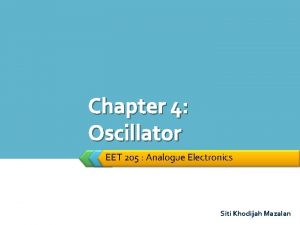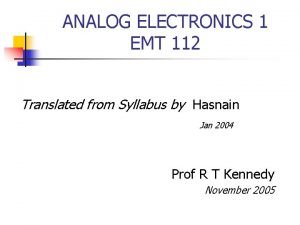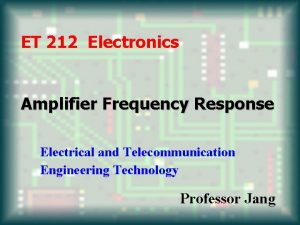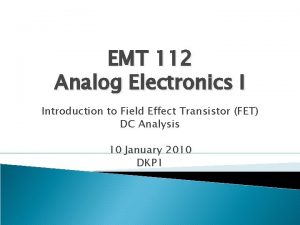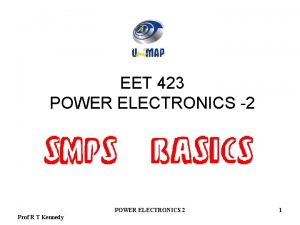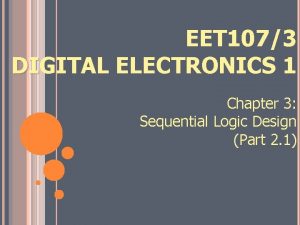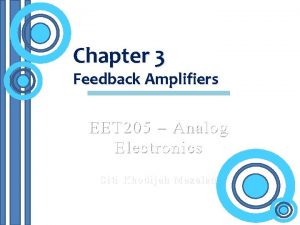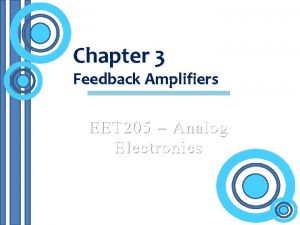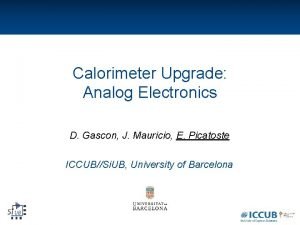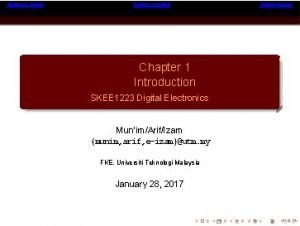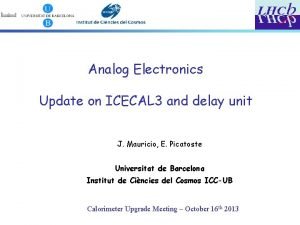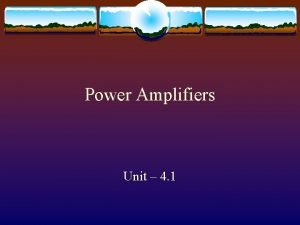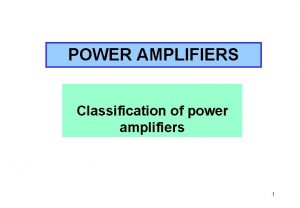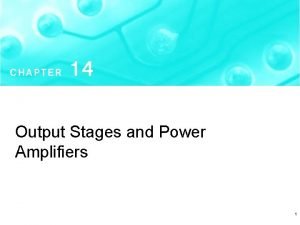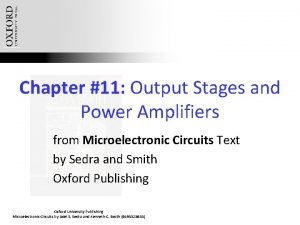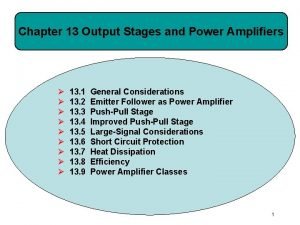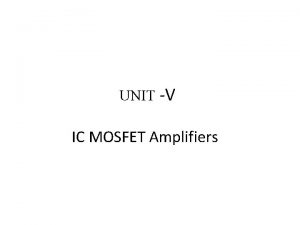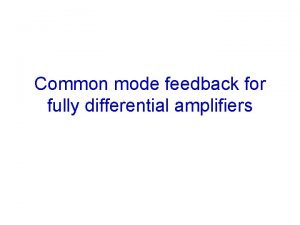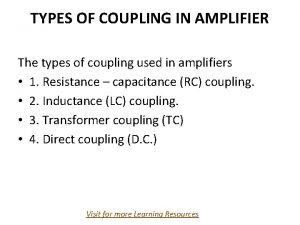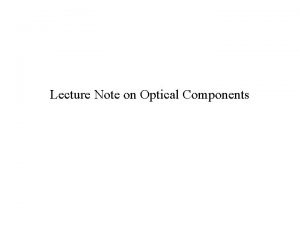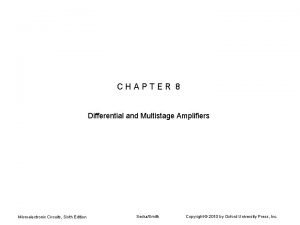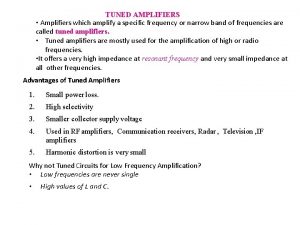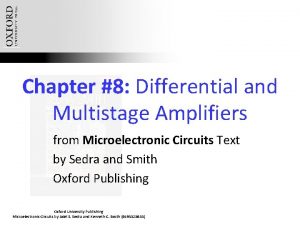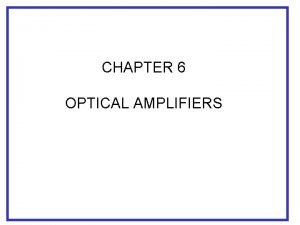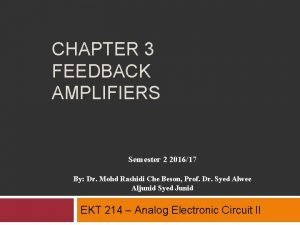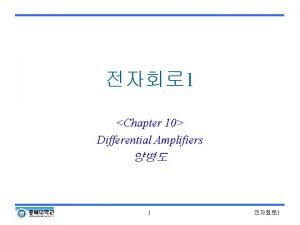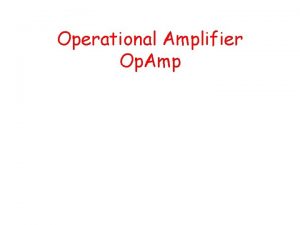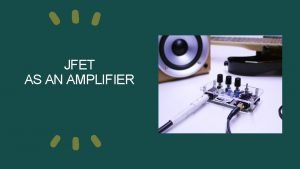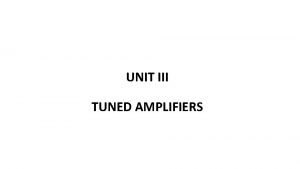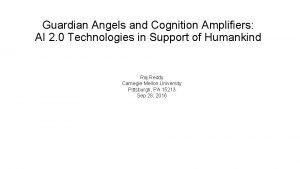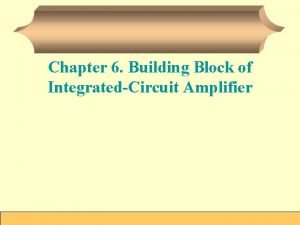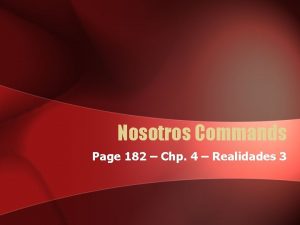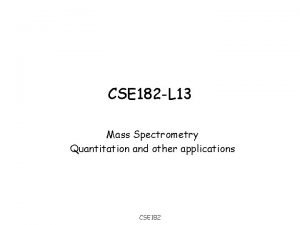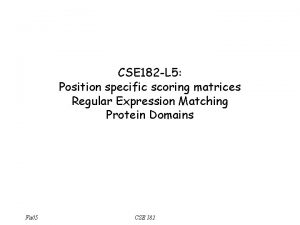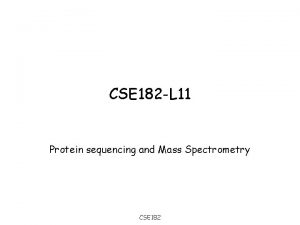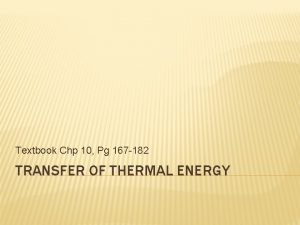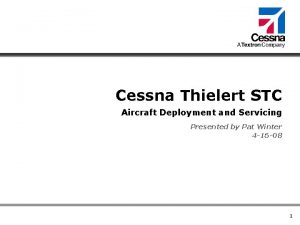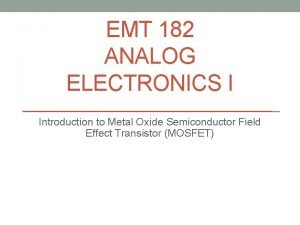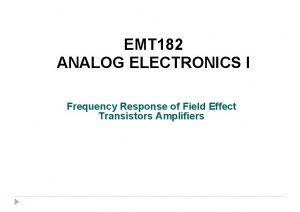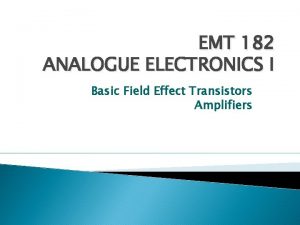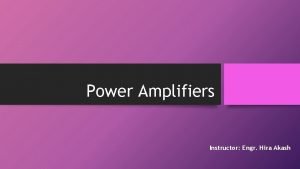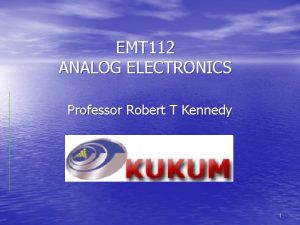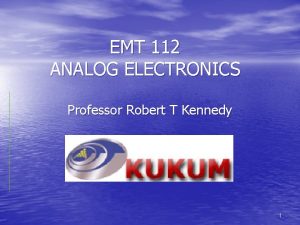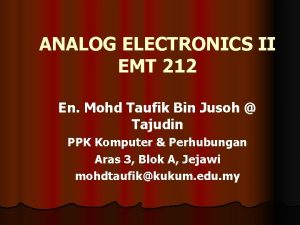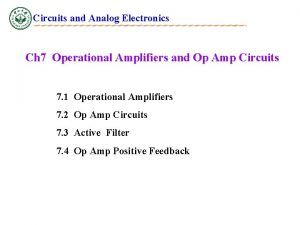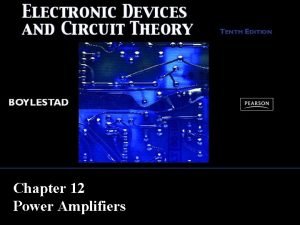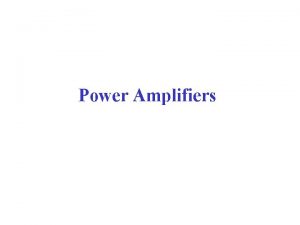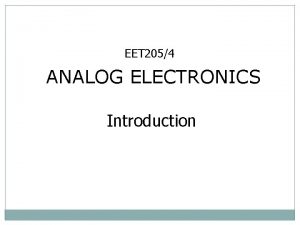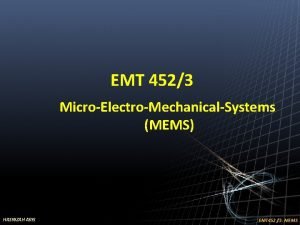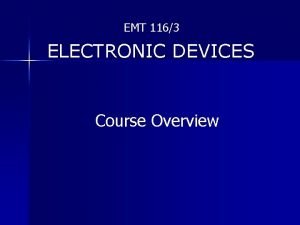EMT 182 ANALOG ELECTRONICS 1 Power Amplifiers POWER















































- Slides: 47

EMT 182 ANALOG ELECTRONICS 1 Power Amplifiers

POWER AMPLIFIER – Classification They are grouped together based on their Q-points on the DC load line.

POWER AMPLIFIER – Classification In class-A; the transistor conducts during the whole cycle of sinusoidal input signal and the output transistor is biased at a quiescent current.

POWER AMPLIFIER – Classification In class-B; the transistor conducts during one -half cycle of input signal

POWER AMPLIFIER – Classification In class-AB; the transistor conducts for slightly more than half a cycle of input signal and the output transistor is biased at a small quiescent current.

POWER AMPLIFIER – Classification In class-C; the transistor conducts for less than half a cycle of input signal

POWER AMPLIFIER – Class-A Operation For maximum swing ( +ve and –ve), transistor is biased such that the Q point is at centre of the load line. The transistor conducts for a full cycle of the input signal

POWER AMPLIFIER – Class-A Operation Instantaneous power dissipation in transistor is; For sinusoidal input signal; And;

POWER AMPLIFIER For maximum possible swing; And; Therefore; – Class-A Operation

POWER AMPLIFIER – Class-A Operation When the input signal = 0, the transistor must be capable of handling a continuous power of; Efficiency; PL = average ac power to the load PS = average power supplied by the source (VCC)

POWER AMPLIFIER – Class-A Operation For maximum possible swing; Power supplied by the source; The efficiency; Maximum theoretical efficiency of class A amplifier is 25% therefore it is not been used when power signals more than 1 Watt.

POWER AMPLIFIER – Class-B Operation Consists of complementary pair electronic devices One conducts for one half cycle of the input signal and the other conducts for another half of the input signal Both devices are off when the input is zero (See Figure)

POWER AMPLIFIER – Class-B Operation When v. I = 0, both A and B are OFF and therefore v. O = 0. The complementary pair

POWER AMPLIFIER When v. I > 0, A is ON and B is OFF and v. O > 0. – Class-B Operation

POWER AMPLIFIER When v. I < 0, A is OFF and B is ON and v. O < 0. – Class-B Operation

POWER AMPLIFIER – Class-B Operation The transfer characteristic of the complementary pair

POWER AMPLIFIER – Class-B Operation Approximate Class-B : Complementary push-pull circuit Assuming ideal transistor; when v. I = 0; both Qn & Qp are off and v. O =0 when v. I > 0; Qn conducts & Qp is off and v. O v. I when v. I < 0; Qp conducts & Qn is off and again v. O v. I.

POWER AMPLIFIER – Class-B Operation Crossover Distortion Assuming cut-in voltage of transistor is 0. 6 V, v. O = 0 for a range -0. 6 V < v. I < 0. 6 V. The transfer characteristic becomes non-linear (See Figure). The range where both transistors are simultaneously off known as the dead band.

POWER AMPLIFIER – Class-B Operation Crossover Distortion The output will be distorted – crossover distortion (Figure)

POWER AMPLIFIER – Class-B Operation Crossover Distortion Crossover distortion can be eliminated by biasing the transistor with small quiescent current when vi = 0 V

POWER AMPLIFIER Idealized Power Efficiency – Class-B Operation

POWER AMPLIFIER Idealized Power Efficiency – Class-B Operation

POWER AMPLIFIER – Class-B Operation Idealized Power Efficiency The Q-point is at the cutoff point of both transistors (zero collector current)

POWER AMPLIFIER Idealized Power Efficiency The output voltage of the idealized class-B is; The maximum possible value of Vp is VCC The instantaneous power dissipation in Qn is; – Class-B Operation

POWER AMPLIFIER Idealized Power Efficiency The collector current is; for and for – Class-B Operation

POWER AMPLIFIER – Class-B Operation Idealized Power Efficiency The collector-emitter voltage is; Therefore the instantaneous power dissipation in Qn is; for

POWER AMPLIFIER Idealized Power Efficiency And; for Therefore, the average power dissipation in Qn is; – Class-B Operation

POWER AMPLIFIER – Class-B Operation Idealized Power Efficiency Plotting PQn versus Vp as given by the equation; gives us the following curve:

POWER AMPLIFIER – Class-B Operation Idealized Power Efficiency Because of symmetry; Differentiating with respect to Vp, for maximum PQn gives us; which occurs when

POWER AMPLIFIER – Class-B Operation Idealized Power Efficiency Since each power source supplies half sinewave of current, the average value is; The total power supplied by the two sources is;

POWER AMPLIFIER Idealized Power Efficiency The power delivered to the load is; The efficiency is; Maximum efficiency occurs when – Class-B Operation

POWER AMPLIFIER – Class-B Operation Idealized Power Efficiency Under this condition; Maximum theoretical efficiency of class B amplifier is therefore 78. 5% The efficiency obtained in practice is less than the maximum value because of other circuit losses and because the peak output voltage must remain less than VCC to avoid transistor saturation which can cause distortion in the output signal.

POWER AMPLIFIER – Class-B Operation Idealized Power Efficiency The maximum transistor power dissipation occurs at; Substituting in the expression for efficiency; As the peak output amplitude is increased, the output distortion signal also increased. Therefore, to limit the distortion, the peak output voltage is limited to several volts below Vcc.

POWER AMPLIFIER Crossover distortion can be virtually eliminated by applying small quiescent bias on each transistor (See Figure) If Qn and Qp are matched, each emitter-base junction is biased with VBB/2 when v. I is zero. Hence v. O is also zero. The quiescent collector currents are; – Class-AB Operation

POWER AMPLIFIER – Class-AB Operation As v. I increases, the voltage at the base of Qn increases and v. O increases. Qn operates as an emitter follower supplying current to RL. The output voltage is given by; The collector current of Qn is; (Neglecting the base currents)

POWER AMPLIFIER Since i. Cn must to supply the load current, v. BEn increases which causes v. BEp to decrease because VBB is constant. The decrease in v. BEp results in a decrease in i. Cp. – Class-AB Operation

POWER AMPLIFIER When v. I goes negative, the base voltage of Qp decreases followed by a decrease in v. O. Qp operates as emitter follower, sinking the load current. As i. Cp increases v. EBp increases causing a decrease in v. BEn and i. Cn. – Class-AB Operation

POWER AMPLIFIER – Class-AB Operation Transfer characteristics (v. O versus v. I)

POWER AMPLIFIER – Class-AB Operation

POWER AMPLIFIER – Class-AB Operation

POWER AMPLIFIER – Class-AB Operation relationship Using the relationship can be written as; , the above expression Hence; The product of i. Cn and i. Cp is constant, therefore if i. Cn increases i. Cp decreases but does not to zero

POWER AMPLIFIER – Class-AB Operation Example III Mn and Mp are matched transistors with the following parameters; If VDD = 10 V and RL = 8 , find the bias voltage VBB/2 for IDQ = 0. 05 A. Find also VGSn, VSGp andv. I if v. O = 5 V.

POWER AMPLIFIER – Class-AB Operation Example III – Solution Since the MOSFETs are matched, at quiescent point; and Hence;

POWER AMPLIFIER – Class-AB Operation Example III – Solution (cont’d) Substituting values; which yields; From the expression we have;

POWER AMPLIFIER – Class-AB Operation Example III – Solution (cont’d) When and

POWER AMPLIFIER – Class-AB Operation Example III – Solution (cont’d) Since; then; And;

POWER AMPLIFIER – Class-C Operation Transistor conducts for less than half a cycle of input signal • • • Tuned circuit is required. Used for RF amplifier. Efficiency > 78. 5% B – E junction is reverse-biased to obtain Q-point beyond cut-off.
 Difference between analog and digital editing
Difference between analog and digital editing Oscillator analog electronics
Oscillator analog electronics Analog electronics
Analog electronics Et 212
Et 212 Analog electronics
Analog electronics Analog electronics
Analog electronics 3 bit up down counter using t flip flop
3 bit up down counter using t flip flop Analog electronics
Analog electronics Analog electronics
Analog electronics Eet 205
Eet 205 Analog electronics
Analog electronics Vhmin
Vhmin Icecal
Icecal Classification of power amplifiers
Classification of power amplifiers Power amplifiers classification
Power amplifiers classification Vbe multiplier
Vbe multiplier Class b output stage
Class b output stage Rippling rpass
Rippling rpass Engine on half power ahead - steer 182 degrees port side.
Engine on half power ahead - steer 182 degrees port side. Whenever you grasp a stretcher or backboard
Whenever you grasp a stretcher or backboard Common source amplifier with current mirror active load
Common source amplifier with current mirror active load Special-purpose op-amp circuits
Special-purpose op-amp circuits Common mode feedback
Common mode feedback Transformer coupling is used for amplification
Transformer coupling is used for amplification Optical amplifiers lecture notes
Optical amplifiers lecture notes Microelectronic
Microelectronic Classification of tuned amplifier
Classification of tuned amplifier Differential and multistage amplifiers
Differential and multistage amplifiers In-line optical dwdm amplifiers
In-line optical dwdm amplifiers Current feedback
Current feedback Active load differential amplifier
Active load differential amplifier Voltage subtractor
Voltage subtractor Operational amplifiers
Operational amplifiers Amplification factor in fet
Amplification factor in fet Shunt-series feedback example
Shunt-series feedback example Tuned amplifier
Tuned amplifier Angels in amplifiers
Angels in amplifiers Emc
Emc Building blocks of integrated-circuit amplifiers
Building blocks of integrated-circuit amplifiers Tungsten-186
Tungsten-186 Nosotros commands
Nosotros commands Cse 182
Cse 182 Department order 182
Department order 182 Heer ons dink aan afrika
Heer ons dink aan afrika Cse 182 ucsd
Cse 182 ucsd Cse 182
Cse 182 Min 167 + 182
Min 167 + 182 Cessna 182 diesel
Cessna 182 diesel

